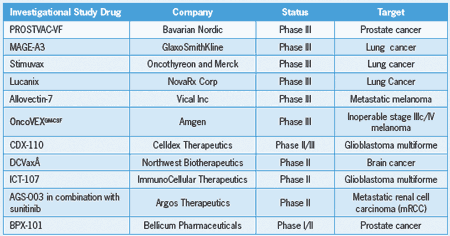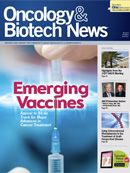Publication
Article
Oncology & Biotech News
Emerging Cancer Vaccines Appear to Be on Track for Major Advances
Author(s):
Both industry and clinical sources agree that cancer vaccine research is finally on the right track to achieve major advances in treatment.

Both industry and clinical sources agree that cancer vaccine research—despite numerous stumbles in the past 15 years—is finally on the right track to achieve major advances in treatment. As one senior CEO of a company hoping to launch a new vaccine within the next several years said: “We’re beginning to figure out how to do this.”
That optimistic assessment is echoed by other clinical researchers and market analysts. For example, GlobalData, an international industry analysis specialist that tracks pharmaceutical development, confidently proclaimed: “The present pipeline for cancer vaccines seems to be very promising, with numerous molecules present in the phase II and III stages. From the market perspective, there are going to be multiple launches of vaccines between 2010 and 2013-14, which would substantially increase the market size and growth.”
This bright outlook is shared by one of America’s foremost researchers in cancer immunotherapy, James P. Allison, PhD, director of the Ludwig Center for Cancer Immunotherapy at Memorial Sloan-Kettering Cancer Center in New York City.
Table: Promising Cancer Vaccines in Advanced Clinical Trials

“The story is encouraging,” said Allison of the variety of vaccine formulations being investigated. (See “Types of Cancer Vaccines Being Investigated.”) Allison is one of the discoverers of the role that T cells and cytotoxic T lymphocyte-associated antigen-4 (CTLA-4) play in spurring the human immune system to attack cancer cells.
Because of this renewed optimism, the cancer vaccine industry appears to be going full speed in trying to find effective treatments. An estimated 130 potential cancer vaccines are now being studied, many in advanced clinical trials (Table), according to analysts.
But that optimism is tempered by past failures of once high-flying investigational cancer vaccines and by the steep cost of the few cancer vaccines that have recently been approved and entered the market.
Researchers and investors have been encouraged by the recent FDA approval of 2 vaccines: sipuleucel-T (Provenge), for the treatment of prostate cancer, and ipilimumab (Yervoy), for the treatment of metastatic melanoma. Provenge, which is manufactured by Dendreon, a company based in Seattle, Washington, was approved in April 2010 and uses a patient’s dendritic cells and cultures them with genetically engineered antigens. Yervoy was approved in March 2011 and is a human monoclonal antibody manufactured by Bristol-Myers Squibb. Allison, at Memorial Sloan-Kettering, was one of the founders of the cellular process on which ipilimumab is based.

Robert L. Kirkman, MD
Robert L. Kirkman, MD, president and CEO of Oncothyreon, which is based in Seattle, said that the START (Stimulating Targeted Antigenic Responses To NSCLC) study is a multicenter, randomized, double-blind, placebo-controlled trial that is evaluating patients with documented, unresectable stage IIIA or IIIB NSCLC. The START study will involve more than 1300 patients in some 30 countries.
At the same time, the companies are sponsoring the Stimuvax INSPIRE (In Asian Patients: Stimulating Immune Response) trial, also a phase III study testing the vaccine in Asian patients with advanced NSCLC. The trial is enrolling approximately 420 patients in China, Hong Kong, South Korea, Singapore, and Taiwan. INSPIRE is similar in design to START and will evaluate the efficacy, safety, and tolerability of Stimuvax in patients with unresectable stage III NSCLC. The primary endpoint is overall patient survival.
The START study is “pretty far along,” said Kirkman. He said the company was encouraged by the “very strong data from the phase II study,” which “showed a very significant 17-month improvement in median survival.” The 3-year survival data from the study, presented in 2007 at the International Association for the Study of Lung Cancer Congress in Seoul, South Korea, showed that patients given Stimuvax had a median survival of 30.6 months, compared to 13.3 months in patients not exposed to the vaccine.
"Cancer vaccines take a while to get started and you must follow patients for some time for reasonable expectations to result."
—Robert L. Kirkman, MD
An effective and life-prolonging treatment for NSCLC is a critical unmet need in medicine. The company said that the condition, which accounts for 85% of all lung cancers (about 1.6 million new cases are diagnosed worldwide each year), is rarely diagnosed at its earliest and most potentially curable stage when it is subject to surgical resection. Most patients are diagnosed when the tumor has already advanced to stage III, when the cancer has invaded the chest tissues or mediastinal lymph nodes and is inoperable, or to stage IV, when the cancer has spread to other organs.
Types of Cancer Vaccines Being Investigated
Antigen vaccines boost the immune system by using only one or a few antigens, rather than whole tumor cells that contain many thousands of antigens. The antigens are usually proteins called peptides. Antigen vaccines may be specific for a certain type of cancer, but they are not made for a unique patient like autologous cell vaccines are.
Scientists can produce many antigens in the laboratory and can change antigens to make them more easily recognized by the immune system. This new technology means that large amounts of specific antigens can now be given to many patients.
Dendritic cell vaccines. Dendritic cells are antigen-presenting cells that help the immune system recognize cancer cells. They break down cancer cells into smaller pieces (including antigens), making it easier for T cells to recognize and attack them.
Dendritic cell vaccines are autologous vaccines and must be made individually for each patient, a complex and expensive process. Physicians remove some of the cells and treat them in the laboratory to make them multiply. This creates many more dendritic cells than if they just used cells taken from the patient. These dendritic cells are then exposed to cancer cells or cancer antigens. The dendritic cells are then reinjected into the patient. Sipuleucel-T (Provenge) is an example of a dendritic cell vaccine.
Anti-idiotype vaccines. Antibodies are made when the immune system responds to antigens. The unique part of each type of antibody is called an idiotype. But the immune system also makes some antibodies that treat other antibodies like antigens (ie, sometimes the body makes antibodies against other antibodies).
Antibodies and antigens can work together as a team. So an antibody to a particular idiotype of another antibody (an anti-idiotype) will usually look like the antigen that triggered cells to make the antibody in the first place. The anti-idiotype antibodies look like the antigen and appear foreign, so injecting them into the body causes the immune system to attack the anti-idiotypes, as well as the antigens themselves. Therefore, they can trigger an immune response against that specific cancer.
DNA vaccines. When tumor cells or antigens are injected into the body as a vaccine, they can initially cause the intended immune response, but their effectiveness may weaken over time. Unless there is further stimulation, the immune system will often return to its normal (prevaccine) state. To circumvent this, scientists have searched for a way to provide a steady supply of antigens to sustain the immune response.
One way to sustain the immune response is through DNA, the nucleic acid that contains the genetic instructions used in all living organisms. Cells can be modified with parts of DNA that code for target antigens, signaling cells to keep making more antigens. These types of therapies are called DNA vaccines.
Researchers have been able to use this process to remove some of a patient’s cells, treat them with DNA that codes for a target antigen, and then return them to the patient. The altered cells would then make the antigen continuously to keep the immune response strong.
Vector-based vaccines. Vectors are delivery systems that can get antigens or DNA into the body. Vectors may include viruses, bacteria, yeast cells, or other structures. Vectors may be used to deliver more than one cancer antigen at a time, which may make the body’s immune system more likely to mount a response. Also, viruses and bacteria vectors may trigger their own immune responses from the body, which may help make the overall immune response even stronger.
Definitions are adapted from the American Cancer Society and National Institute of Cancer of the National Institutes of Health (NIH).
The target of the Stimuvax vaccine, Kirkman said, is the mucin-1 (MUC-1) glycoprotein, a tumor-associated antigen that is greatly overexpressed on tumors in lung, pancreatic, breast, and prostate cancers. Consequently, Kirkman said, if Stimuvax proves effective and safe, it might be useful “in a broad range of cancers.”
Kirkman is aware of the large number of investigational cancer vaccines that have fallen by the wayside after disappointing trials. Consequently, he said, vaccine developers must have the patience and resources to commit to extended clinical trials. “Cancer vaccines take a while to get started and you must follow patients for some time for reasonable expectations to result,” he said.
Nevertheless, he said, the current research has buoyed the hopes of all cancer vaccine investigators. “We’re beginning to figure out how to do this,” he said of the various processes being tested to attack malignant cells (see “Basic Categories of Cancer Vaccines”). “Now we have 2 vaccines (Provenge and Yervoy) and these have gone a long way to encourage people that the approach works,” Kirkman said.
An advantage of vaccines such as Stimuvax is that they are allogeneic, also known as “off-theshelf” (ie, peptide-based products that can be injected in any qualifying lung cancer patient). “Our vaccine is not patient-specific,” Kirkman said, contrasting Stimuvax with patient-specific (autologous), whole-cell vaccines that must be taken from a patient’s own tumors.
While Kirkman and his group are looking forward to the completion of their vaccine’s phase III trial, projected sometime next year, Edward G. Shaw, MD, is part of a team just beginning a phase I trial for another cancer vaccine—this one for brain cancer. Shaw, a professor of radiation oncology at the Wake Forest University Baptist Medical Center in Winston-Salem, North Carolina, is testing the vaccine in patients with low-grade gliomas. In fact, the patients in his trial will be the first humans tested for these kinds of slow-growing brain tumors.
“The vaccine is similar to many vaccines used to prevent infectious diseases in that it’s a process of passive immunity,” Shaw explained. The study will determine whether patients who receive the vaccine (antigen peptides in combination with poly-ICLC) can develop an immune response, thereby spurring cytotoxic T lymphocytes (CLTs) against the glioma cells. The study (Effects of Vaccinations With HLA-A2-Restricted Glioma for Adults With High-Risk WHO Grade II Astrocytomas and Oligo-Astrocytomas) is being undertaken in collaboration with the immunologist Hideho Okada, MD, PhD, and his research group at the University of Pittsburgh in Pennsylvania.
Shaw, who has worked in cancer research for more than 25 years, said he is “cautiously optimistic that this is the way to go.” The target date for the completion of the low-grade glioma trial is the end of this year, Shaw said.

Clifford S. Goodman, PhD
In addition to proving efficacy, other challenges that cancer vaccine developers face are safety and cost, according to Clifford S. Goodman, PhD, senior vice president of the Lewin Group, a healthcare policy and management consulting firm based in Falls Church, Virginia.
“Like other cutting-edge technologies, cancer vaccines will be subject to higher evidence requirements for demonstrating safety and effectiveness,” said Goodman, who has led nationally recognized studies in such areas as organ transplantation. He serves as chair of the Medicare Evidence Development and Coverage Advisory Committee (MEDCAC) for the Centers for Medicare & Medicaid Services (CMS). The MEDCAC provides independent guidance and expert advice to CMS and reviews and evaluates clinical data on the effectiveness of drugs and services either covered under Medicare or that may be eligible for coverage under Medicare. The MEDCAC judges the strength of the available evidence and makes unbiased recommendations to CMS based on that evidence.
"The FDA does not consider cost effectiveness in making coverage decisions, but that ‘smart companies [that] are doing their homework’ need to be aware of ‘the financial environment...tempered by regulatory and payment requirements that will mediate access’ to new drugs."
—Clifford S. Goodman, PhD
Goodman, who has testified to Congress on issues pertaining to Medicare coverage of healthcare technology, said the FDA does not consider cost effectiveness in making coverage decisions, but that “smart companies [that] are doing their homework” need to be aware of “the financial environment...tempered by regulatory and payment requirements that will mediate access” to new drugs. In expanding on this theme, Goodman stated, “The cost of these (new vaccines) may pose a barrier to access, depending on patient cost-sharing arrangements” such as patient copay and insurance coverage.
The issue of cost is sensitive because the industry-set price tags for Provenge and Yervoy—$93,000 and $120,000, respectively— have certainly raised eyebrows among healthcare specialists and regulators.
Basic Categories of Cancer Vaccines
Autologous vaccines are made from killed tumor cells that are surgically taken from the patient in whom they will later be used. The cells are treated and then injected back into the patient. Autologous tumor cell vaccines have potential drawbacks: the expense can be prohibitive in creating a new, unique vaccine for each patient; and cancer cells tend to mutate over time, so an autologous tumor vaccine might become less effective later if the cancer cells in the body change.
Allogeneic vaccines use the cells of a particular cancer type that come from someone other than the patient being treated. These vaccines are not geared for just one person and are often called off-the-shelf vaccines because they are intended for many patients. Once these cells are treated they are usually injected with one or more adjuvant substances to stimulate the immune system.
Cancer preventive vaccines are designed to prevent cancer from developing.
The FDA has approved 2 types of cancer preventive vaccines: vaccines against the hepatitis B virus, which can cause liver cancer, and vaccines to prevent human papillomavirus (HPV), which can cause cervical cancer.
The vaccines available for hepatitis B include Engerix-B (GlaxoSmithKline) and Recombivax HB (Merck). There is also a combination vaccine for hepatitis A and B available for adults, Twinrix (GlaxoSmithKline). These vaccines are given intramuscularly.
The approved vaccines against human papillomavirus types 16 and 18 are Gardasil (Merck) and Cervarix (GlaxoSmithKline), both of which are HPV quadrivalent vaccines. The types of HPV that these vaccines prevent are responsible for about 70% of cervical cancer cases.
Cancer treatment vaccines are intended to treat existing cancers. So far, the FDA has approved 2 vaccines to treat cancer that has already occurred. Sipuleucel-T (Provenge) is a dendritic cell vaccine for the treatment of metastatic castration-resistant prostate cancer. Ipilimumab (Yervoy) is a human monoclonal antibody approved for the treatment of advanced melanoma.
Definitions are adapted from the American Cancer Society and National Institute of Cancer of the National Institutes of Health (NIH).
Aside from cost, the FDA has sounded a sobering warning against excessive euphoria about the current state of cancer vaccine research. Peter F. Bross, MD, the medical review officer in the FDA’s Office of Cellular, Tissue, and Gene Therapy, reminded everyone that “there is no well-established roadmap for clinical development of cancer vaccines, and the clinical development paradigms for more traditional chemotherapeutic agents may not apply to cancer vaccines.” For example, Bross said, “Unlike traditional chemotherapeutic agents, a cancer vaccine may improve survival without causing the tumor to shrink. A cancer vaccine may require substantial time after administration to produce the immune response necessary for effectiveness. Assays to measure this immune response tend to be difficult to standardize, and the assay results may not be reliable.”
Moreover, Bross said: “In the absence of tumor shrinkage or a reliable assay, it can be difficult to detect clinical activity, select the most promising dose and regimen, or determine whether the product is promising enough to deserve further study. Therefore, cancer vaccine development programs often rely on singlearm studies with historical comparisons which may not be reliable predictors of the activity of the product. In the absence of an established surrogate, such as tumor shrinkage, for clinical benefit, development of cancer vaccines will likely require long-term studies with survival endpoints that take years to reach.”
In addition to the several dozen cancer vaccines in advanced trials, many more are being tested in animal studies. An example is Oncothyreon’s other investigational cancer vaccine, ONT-10, which also targets the MUC-1 glycoprotein. Kirkman said the vaccine is now in animal studies and is designed to trigger a T-cell response to cancer cells.
Allison said the research is convincing that all cancer vaccines need a co-stimulatory signal teaming with the main treatment molecule to successfully halt the cellular proliferation in cancer—a necessary “one-two punch,” if you will.
One of the key lessons that cancer vaccine researchers are learning, Allison said, is that immunotherapy should concentrate on “treating the immune system, not the tumor.”































%20(2)%201-Recovered-Recovered-Recovered-Recovered-Recovered-Recovered-Recovered-Recovered-Recovered-Recovered-Recovered-Recovered-Recovered-Recovered-Recovered-Recovered-Recovered.jpg?fit=crop&auto=format)
%20(2)%201-Recovered-Recovered-Recovered-Recovered-Recovered-Recovered-Recovered-Recovered-Recovered-Recovered-Recovered-Recovered-Recovered-Recovered-Recovered-Recovered-Recovered.jpg?fit=crop&auto=format)
